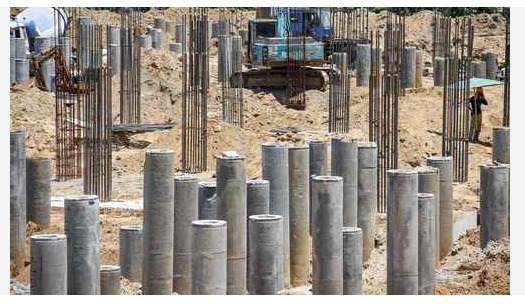Types of piling foundations construction
A pile foundation is a deep foundation system that transfers structural loads to a deeper, more competent soil layer. It’s crucial for buildings constructed on weak or unstable soil, or where the load-bearing capacity of the upper soil layers is insufficient. Let’s explore the different types of pile foundations used in construction.
1. Driven Piles
Driven piles are one of the most common types of pile foundations in construction. These piles are pre-manufactured and then driven into the ground using a pile driver. They are often made of concrete, steel, or timber. The primary advantage of driven piles is their ability to penetrate through weak soil layers to reach a more stable stratum. They are ideal for heavy structures and are often depicted in a pile foundation diagram showing their deep placement in the soil.
2. Bored Piles
Bored piles, also known as drilled shafts, involve boring a hole into the ground and then filling it with concrete. This type of pile foundation is suitable for sites where noise and vibration from pile driving are concerns. Bored piles can be constructed to great depths and diameters, making them suitable for large buildings and bridges. They are particularly useful in urban areas where minimizing disruption is crucial.
3. Screw Piles
Screw piles, or helical piles, are types of piling in construction that resemble giant screws. They are screwed into the ground using hydraulic machinery. Screw piles are quick to install and can be used in various soil conditions. They are ideal for projects requiring rapid installation and immediate load-bearing capacity, such as temporary structures or emergency repairs.
4. Steel Piles
Steel piles are commonly used in construction due to their high strength and durability. They come in various shapes, including H-piles, pipe piles, and sheet piles. Steel piles are driven into the ground and are suitable for deep foundations and retaining walls. Their versatility makes them a popular choice in many types of piling foundations.
5. Timber Piles
Timber piles have been used in construction for centuries. Made from treated wood, they are suitable for lighter structures such as residential buildings and temporary works. Timber piles are driven into the ground and are cost-effective compared to other types of piling in construction. However, their use is limited to areas with low exposure to decay and insect attack.
6. Composite Piles
Composite piles combine two or more materials, such as concrete and steel, to take advantage of the strengths of each. For example, a concrete-filled steel pipe pile provides the compressive strength of concrete and the tensile strength of steel. Composite piles are those types of piling in construction that are versatile and can be customized to meet specific project requirements. They are often used in marine environments and bridge foundations.
7. Mini Piles
Mini piles, also known as micro piles, are small-diameter piles used in situations where traditional types of piling in construction are impractical. They are ideal for sites with restricted access or where minimal vibration is required. Mini piles are often used in underpinning existing structures and in areas with challenging soil conditions. Despite their small size, they provide significant load-bearing capacity.
8. Floating Piles
Floating piles, also known as friction piles, rely on skin friction between the pile surface and the surrounding soil to carry the load. These types of piling work in construction do not reach a stable stratum but derive their support from the soil along their length. Floating piles are suitable for soft soils where end-bearing piles are impractical. They are commonly used in residential and commercial building foundations.
Conclusion
Concrete piles, steel piles, and composite piles offer robust solutions for various load requirements, while timber piles provide a cost-effective option for lighter structures. Whether you are dealing with urban constraints, marine environments, or challenging soil conditions, there is a pile foundation method to suit your needs. Proper planning and execution of piling work in construction will lead to successful and enduring projects, supported by the right foundation system.



